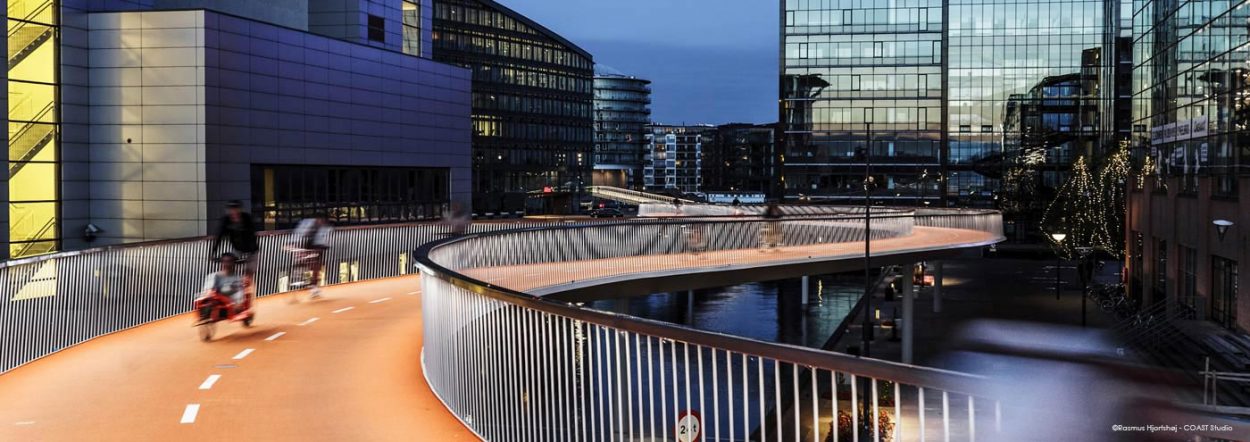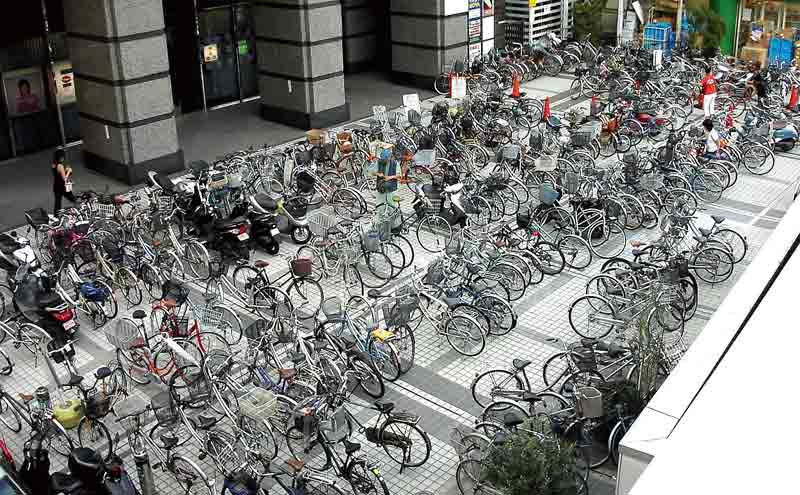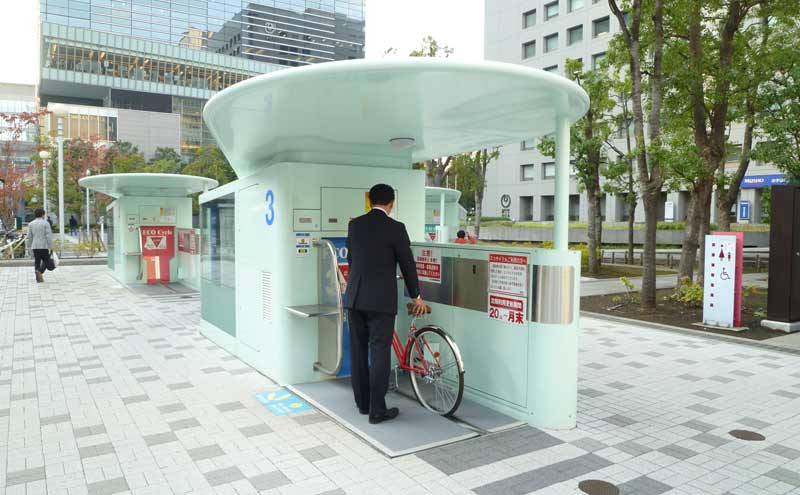Escalating populations and increased environmental awareness have prompted city dwellers to find a greener way of commuting: the bicycle. An influx in cycling creates particular infrastructure problems that city developers and planners must solve with more creative solutions. Cities like Copenhagen in Denmark, Tokyo in Japan and Utrecht in the Netherlands are flooded with cyclists riding in their designated lanes; however, the question still remains: Where will they park? Bicycle-littered sidewalks and building entrances, that clog needed space for potential emergency solutions, are trouble spots for vandalism and theft.
Despite bicycle saturation in public spaces, cities promote cycling as a means of transportation for several reasons, one being economical savings. The 2015 Copenhagen Index, (a 13-category bicycle-friendly city evaluation run by Copenhagenize Design Co.) lists the world’s top 20 cities for cyclists and explains that “studies from Denmark tell us that for every kilometer cycled, society enjoys a net profit of 23 cents, whereas for every kilometer driven by car we suffer a net loss of -16 cents.” Cities are responding by creating the infrastructure that encourages two-wheeled commuting and public transportation and discourages personal car use.
A European Role Model
Implementing infrastructure in response to parking needs is being done in creative ways. Designers and city developers in the Netherlands are resourcefully identifying unused spaces for safe bicycle storage. For instance, there is a 4,200-capacity bicycle depository aptly constructed under the colossal entrance stairs of the Utrecht Central Station. The Utrecht municipality, Netherlands’ Railways and ProRail underwent this project as contractors, overseeing the construction of this three-story bicycle garage with 37 rows of double-decker storage racks.
Rotterdam-based architecture design studio Kraaijvanger designed the parking station to where cyclists walk their bicycles down a set of stairs, which have four built-in smooth grooves that allow for effortless bicycle passage. This special bicycle staircase is replicated throughout the parking garage so that access to other floors can be easily attained. All the spaces are conveniently numbered and cyclists can quickly find their bicycle after it has been parked.
Many cyclists will ride to the train station, park their bicycles and commute to work by train. These train-commuting cyclists need a safe place to leave their bike during the workday, but they also need parking to be affordable. Kraaijvanger’s parking station offers the first day for free and 1.25 euros per day, meaning that a cost only accumulates if the bike is parked in the station for more than one day.
While Kraaijvanger’s parking system depicts positive infrastructure against bicycle pile-ups in cities, other projects seem underway in the Netherlands. According to the Dutch newspaper Parool, a bicycle parking garage is said to soon be built under the IJ River in Amsterdam. The garage will provide 7,000 spaces.
“Culture Aboveground, Function Underground”
Solutions outside Europe demonstrate technological advancement, seen in several areas of Tokyo. Japanese construction company GIKEN works with press-in technologies and supports the “Culture Aboveground, Function Underground” concept. The mechanically powered ECO Cycle GIKEN designed is a cylindrical underground parking system with 204 parking spaces.
The ECO Cycle is aesthetically pleasing, earthquake resistant and constructed with the environmentally friendly press-in method. This method is executed by pushing poles into the ground with a hydraulic static load that prevents vibration. The machinery used is small and lightweight; as a result, construction sites are compact and not unsightly. ECO Cycle is installed using sustainable materials and can be easily removed.
The use of the ECO Cycle is simple and safe. The bicycle is equipped with an IC tag that works as a sensor to open the booth door that then secures the front wheel of the bicycle to a mechanical carrying lift. After, the cyclist simply pushes a button and the bicycle is taken and stored underground. To retrieve the bicycle, the cyclist swipes their corresponding IC card and the carrier lift takes the bicycle from storage back above ground.
“The anti-seismic design, parking efficiency (little space is required per bicycle), speed (bicycle retrieval takes about 8 seconds), easy operation and [there is] no risk about your bicycle being stolen or vandalized,” make the ECO Cycle a city asset, explained GIKEN representative Tsunenobu Nozaki to ArchiExpo.
The ECO Cycle can accommodate all types of bicycles, even ones equipped with front baskets and child seats. The most recent ECO Cycle was installed in Mikawadai Park in Tokyo in March 2013.
An Opportunity up for Grabs
 Copenhagen, Denmark wants to be the world’s number one cycling town and is striving to hit a bicycling rate of 50% by the end of 2015. Helping to reach this goal is the newly constructed Bike Snake, Cykelslangen in Danish, which opened in summer 2014. The Bike Snake is a 230-meter long, bright orange sky bridge that connects riders from the Dybbølsbro Bridge to the Bryggebro Bridge, stretching across the Copenhagen Harbor.
Copenhagen, Denmark wants to be the world’s number one cycling town and is striving to hit a bicycling rate of 50% by the end of 2015. Helping to reach this goal is the newly constructed Bike Snake, Cykelslangen in Danish, which opened in summer 2014. The Bike Snake is a 230-meter long, bright orange sky bridge that connects riders from the Dybbølsbro Bridge to the Bryggebro Bridge, stretching across the Copenhagen Harbor.
DISSSING+WEITLING, a Copenhagen architecture studio, won the contract to design the bridge that was proposed by the city of Copenhagen and Copenhagen-based Rambøll engineered the bridge. It was constructed to evoke Copenhagen’s joy of cycling. However, the completion of this bridge and the fact that 12,500 cyclists are using it daily helped spotlight one of Copenhagen’s downsides: parking. Copenhagen has no infrastructure directly aimed at parking, and that leads to unsightly, blocked sidewalks and a tenuous situation for cyclists; with no real infrastructure, theft is easily achieved. While most cyclists are pleased with cycling conditions overall, BBC News Online reported in 2014 that only 29% are satisfied with bicycle-parking facilities. Architects and city planners should see this as an opportunity worth taking.

The movement toward cycle commuting is a step in the right direction for the environment and public health, plus it is economically smart. The increase in bicycle commuting and decrease in personal car use means less CO2 emissions, traffic and noise. As more people take advantage of the benefits of bicycling, cities will need to continue to adapt. Affordable bicycle parking infrastructure that intelligently uses space and preserves safety is a must as bike-friendly cities continue to emerge.















